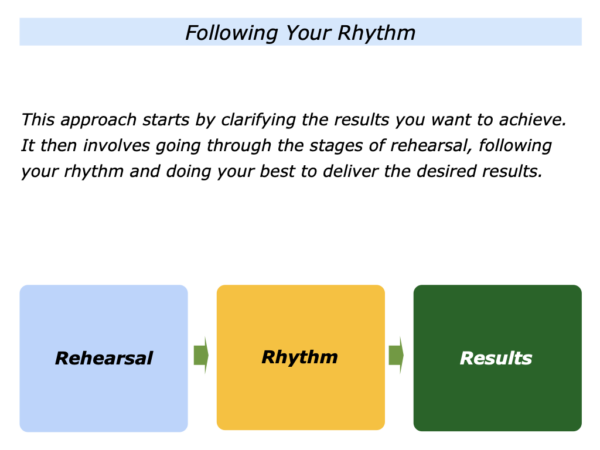
Great workers often aim to follow their chosen rhythm in order to get the desired results. This also enables them to feel in control and maintain their wellbeing on the way towards achieving their goal.
Imagine that you want to follow elements of this approach in your own way. The approach starts by clarifying the results you want to achieve and translating these into a clear picture of success.
It then involves going through the stages of rehearsal, following your rhythm and doing your best to deliver the desired results. Let’s explore how it is possible to focus on these themes.
Results
The first step is to think of a situation where you may want to achieve a specific goal. You may want to encourage a person, do a piece of work, lead a team, tackle a challenge or do another activity.
Imagine that you have chosen to work towards a specific goal. Bearing in mind what you can control in the situation, you can explore the following steps.
What are the real results I want to achieve? What is the picture of success? What will be the benefits of achieving these goals? What will be happening that will show I have achieved the picture of success?
What are the strategies I can follow to give myself the greatest chance of success? How can I translate these into a clear action plan? How can I get some early wins? How can I do my best to achieve the picture of success?
Let’s assume you have explored these themes. If appropriate, you can summarise these in the following way. You can then move on to the next stage.
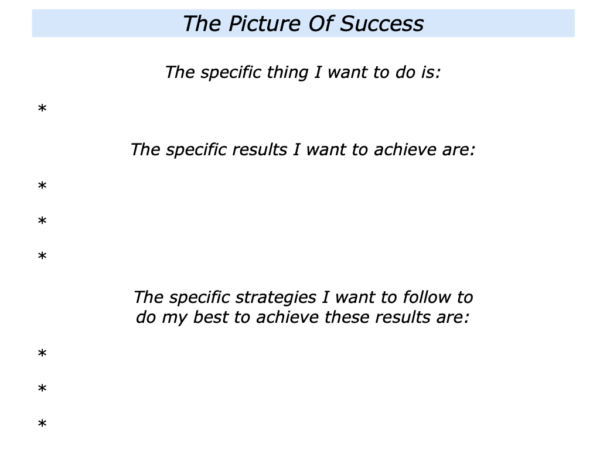
Rehearsal
Great workers often rehearse what they are going to do next. Sometimes they spend a long time taking this step. Sometimes they take a short time – especially when they need to make quick decisions.
Imagine that you are going to take this step. You will, of course, do this in your own way. If appropriate, however, one approach is to work through the following stages.
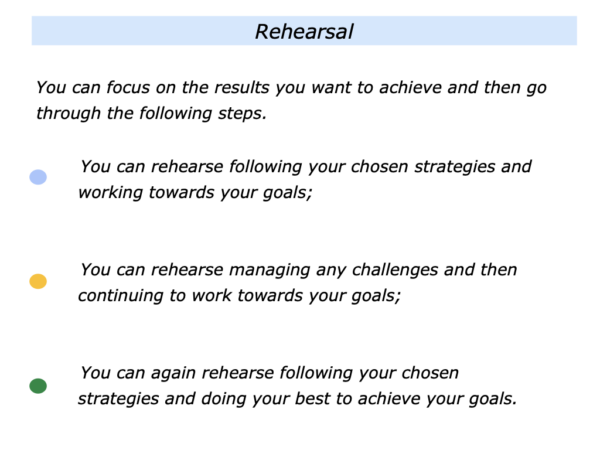
Imagine you have prepared properly by rehearsing these things. You are now ready to move into action. One approach is to focus on the following theme.
Rhythm
This step involves following your chosen rhythm – your preferred way of working – when following the strategies. It also involves regaining your rhythm after managing any challenges.
Every person has their own rhythm for living, working and resting. Some people learn to find and follow their chosen rhythm. They are then able to channel their energy in a positive way.
This can work well if they are working alone. If they are working with others – such as individuals, teams and organisations – they may need to recognise and manage other people’s styles.
Some people do this successfully but others sometimes lose their own rhythm. This can lead to them feeling strangers to themselves.
Imagine that you want to pursue your preferred way of working whilst recognising and, when appropriate, managing other people’s rhythm. Here are some steps to consider.
Finding And Following
Your Own Rhythm
You will have different rhythms for different activities. So start by selecting a specific activity where you want to find and follow your preferred pattern.
Different people do this in different ways. One person began looking at their preferred way of working in the following way. They said:
“I chose to focus on my working week. Some of my work was satisfying, but sometimes I felt disjointed. It seemed like I was fitting into other people’s patterns, rather than my own.
“Some give-and-take is obviously necessary when you work for a company. After all, the business won’t change to fit your rules, but things felt out of sync. So I sat down and planned the best way to follow my natural rhythm during the working week.
“My first step was to identify when and where I worked best. My most productive times in the office are in the morning – between 7.30 and 11.30. So I organised my diary to, as far as possible, be in charge of my own agenda during those times.
“My most creative work is done in a quiet place away from interruptions. So I found a quiet corner to work on my laptop away from the open plan office.
“I felt quite energetic working in the office on Monday and Tuesday, but then wanted to be on the road, visiting clients. So that is how I arranged my diary. Meeting customers on Wednesday and Thursday, with Friday spent working from home.
“Internal meetings remained a challenge. I preferred meeting where I knew the purpose and agenda, rather than those that drifted. Bearing this in mind, I did two things.
“First, I emailed my boss the day before our regular catch ups to outline what I wanted to discuss. I did this diplomatically, of course, underlining we would be following his agenda.
“Second, when asked to attend other internal meetings, I requested the agenda before I accepted the request.
“Taking these steps helped me to be much more productive. I now feel more in sync with my preferred working pattern.”
Different people choose different ways to set up and follow their rhythm. Here are some steps they take. You will, of course, adapt these in your own way.
Great workers often organise their time into blocks. They follow this pattern whether they are planning a day, a week, a month or a longer period of time.
A person may prepare by following their chosen ritual. They relax, refocus and rehearse what they are going to do next. They click into action and go into their version of the arena.
Fully present, they aim to flow, focus and finish. They do their best to deliver the desired results. Such a person may then take time to reflect. They relax, refocus and rehearse. They then repeat the process on the way to doing good work.
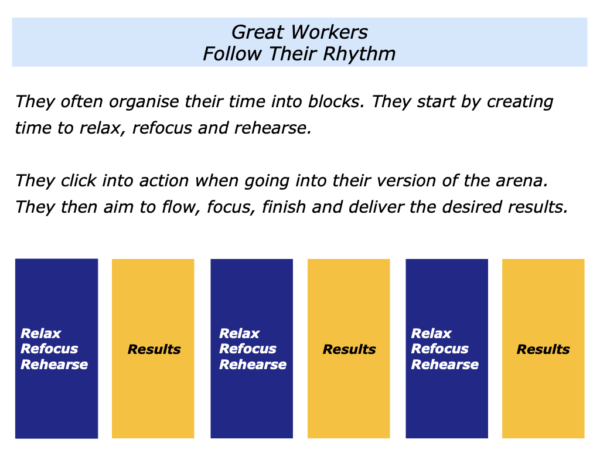
Imagine that you have found the rhythm you want to follow. You can then be positively engaged and pursue it in your own way. This can be rewarding, but it is also important to take care of yourself.
Peak performers focus on getting results, but they recognise this calls for building in times for rest and recovery. Failing to do so can mean they crash and burn.
Different people have different ways of regaining energy. You may choose to sleep, walk, listen to music, play sports or whatever. It can be useful to find and follow your own way to rest and recover. This can help you to deliver even better results.
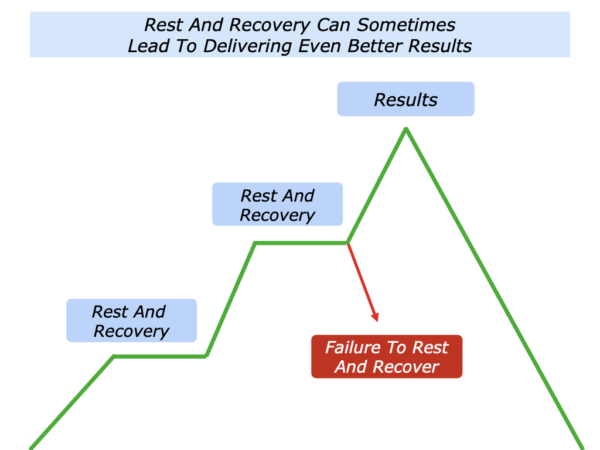
Following Your Rhythm
When Pursuing A Road Map
This approach involves following your rhythm when pursuing a road map on the way towards achieving the desired results. It involves starting from the destination and working backwards.
You can aim:
To clarify the results to achieve;
To make a road map towards achieving those results;
To then follow your rhythm when pursuing the road map on the way towards achieving the results.
The key will be to follow your rhythm, manage and challenges and do your best to achieve the results.
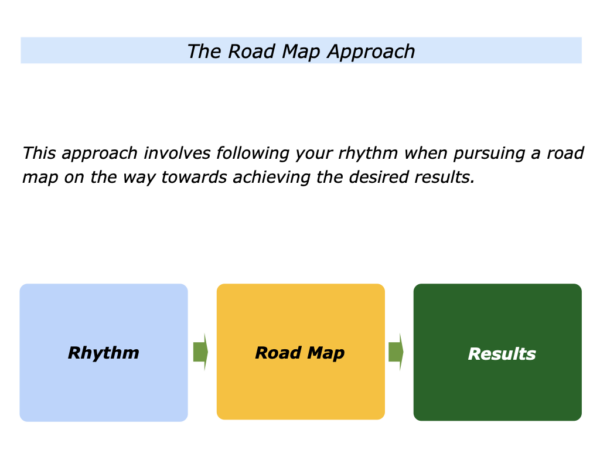
Following Your Rhythm Whilst
Managing Other People’s Rhythm
It can be helpful to follow your rhythm. You may also wish to find ways to deal with situations where the people, team or organisation has a different working pattern.
Organisations have the right to set their own working style, so it is important to recognise their rhythm. This does not necessarily mean, of course, that the approach they choose is effective.
It can be useful to take the following steps when working in an organisation.
Step One:
To, whenever possible, follow your rhythm for delivering results.
Step Two:
To recognise the organisation’s rhythm – such as the way it schedules meetings, the business cycle and any other events;
To prepare properly to make your best contribution to these events;
To make a positive contribution to the events and help the organisation to deliver its desired results.
Step Three:
To then take time to relax, regain your own rhythm and continue to deliver results.
Sometimes you may also encounter individuals whose style creates challenges. Let’s explore this theme.
Following Your Rhythm Whilst Learning
How To Manage Other People’s Rhythm
You will have a preferred way of working, listening and communicating with people. But there will be many occasions when you meet people who have different styles.
Imagine that you like to reflect before speaking. Sometimes you will work with people who talk quickly and demand a response. How to deal with such a situation?
It can be useful to pause, buy time to think and then give a professional response. One person explained how they took this approach in the following way.
“I used to have difficulty with managers who spoke quickly and aimed to spur others into action.
“My own style is more reflective. But, for a while, I tried to match the quick talkers and respond.
“Later I learned to be calm. I did this by learning to breathe properly, listen fully and try to summarise what a manager had said.
“Then I spoke in my own speed, reassuring them that I would fix things. If necessary, I checked information to make sure I was clear on what they wanted and by when.
“Whilst I absorbed information in my own way, the key was to then quickly produce results. This helped me to retain my sanity and also satisfy the manager.”
This approach can work when you plan ahead and prepare properly.
Sometimes you may be interrupted unexpectedly, however, when deep into a piece of work. Let’s explore this theme.
Managing Transitions
Between Activities
Great workers often immerse themselves deeply in their chosen activity. This has huge benefits, but there can also be challenges. They may be deeply engaged in an activity but then be interrupted.
This can throw them off-course. When does this happen for you? You may need to stop what you are doing and aim:
To give full attention to a loved one – your child, partner or another person … To manage your manager who wants to talk with you urgently … To deal with an unexpected event or crisis.
There are many ways to make such transitions. One approach is to go through the following steps.
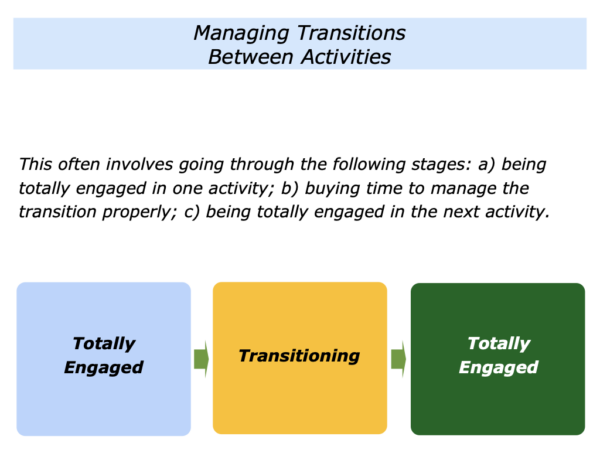
You enjoy doing deep work, but then there is an interruption. Seeing things in perspective, you believe it is important to make a good transition to the next activity. One approach is to take the following steps.
Relax
Relax your mind and body. Breathe deeply and buy time to think, even if only for a few seconds.
Rehearse
Clarify the real results you want to achieve in the next situation. You can then rehearse how to achieve these aims.
Refocus
Focus fully on the new situation and move into action. Be totally aware of what is happening and do your best to achieve the desired results.
Tom Weede wrote an article on this theme called Learning From Biathletes. Writing in Men’s Fitness, he described how athletes competing in the biathlon must switch from high intensity skiing to the calmness required to shoot at a target.
This calls for stopping, concentrating fully when shooting and then regaining their former rhythm. Here is an excerpt from the article where he describes the skills that biathletes employ.
De-stress In Seconds
As a result of the alternating demands of furious cardio and calm precision, these biathletes have to know how to relax and focus in highly stressful situations.
Remain Calm
On days when you’ll be called upon to do something stressful, practise staying relaxed throughout the day — as opposed to hastily trying to compose yourself when you’re about to give a presentation or line up a one-metre putt.
Breathe Deeply
In addition to being in good condition, biathletes increase their ability to relax and lower their heart rates by breathing correctly, deeply inhaling and exhaling as they approach the shooting range during a race.
Make It Mechanical
One way to reduce stress is by practising something over and over until it becomes automatic.
But biathletes can miss their targets, just as the rest of us miss free throws or lose our train of thought. So what happens if you fall out of the automatic mode and mess up?
“You definitely have to stop,” says team member Jeremy Teela, who deals with such times by taking two breaths, closing his eyes for a second and then starting over.
“I jump back into it, just like I would if it was a new shooting,” he says. “And then I shoot the next shots just as fast as normal … so I totally clear what I just did (from my mind) and then start over.”
Regaining Your Rhythm
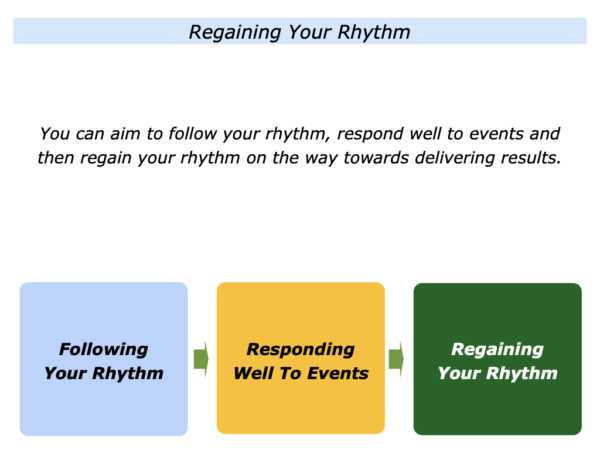
Great workers aim to make things as predictable as possible. Sometimes they are able to follow their rhythm, make things routine and achieve the desired results.
Sometimes they may encounter random or unpredictable events that can throw them off-course. Buying time to think, they then clarify what is happening and take the following approach.
They clarify how to deal with any immediate challenges, take the necessary action and they then clarify the future picture of success;
They clarify the possible ways forward – together with the pluses and minuses of each option – and settle on their strategy for working towards the picture of success;
They clarify how to follow their chosen strategy, regain their rhythm and do their best to achieve the picture of success.
Great workers then take action to do something to get a quick win. Building on this success, they then aim to follow their rhythm on the way towards achieving their goals.
There are many aspects to following your rhythm. This section concludes by considering the following theme.
Pacing Yourself To
Get Positive Results
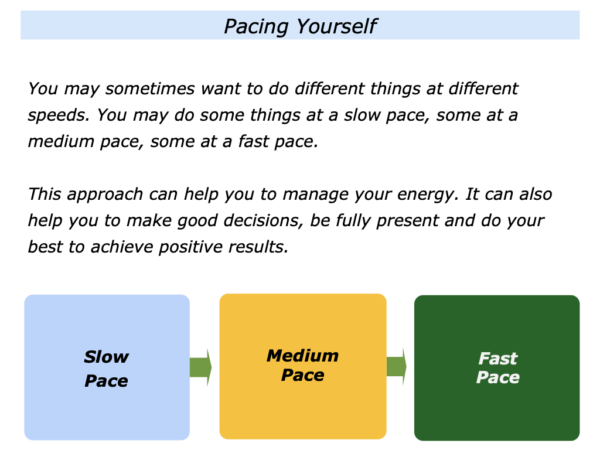
Great workers do things at the right pace to get positive results. Some things need to be done slowly. Some things need to be done quickly.
Sometimes it can be hard to answer the question: “What is the right pace for doing things?” One possible answer is: “The right pace is the one that gets the right results.”
Great workers spend a lot of time clarifying the real results they want to achieve before moving into action. They may then do some tasks extremely quickly, whilst others they may do slowly and deliberately.
Such workers also learn to manage their energy as they get older. They aim: a) to manage their physical energy; b) to manage their psychological energy. They learn to rest, recover and then be fully present in order to deliver positive results.
Imagine that you are following your rhythm and performing superb work. This can lead to the next step.
Results
Great workers keep delivering high standards, reading reality and focusing on continuous improvement. Sometimes they reach the goal by adding that touch of class. Let’s explore these themes.
You Can Focus On
Continuous Improvement
Imagine you are doing superb work. You can also be proactive, keep scanning the situation and reading reality. One approach is to focus on:
The specific things that are going well and how to build on these things;
The specific things that could be done better and how to improve these things;
The specific things that could happen in the future and how to deal with these situations.
You can then implement your ideas, get some quick successes and stay ahead of the gain.
You Can Finish Successfully
How to take this step? One approach is to look back at some of the things you have finished successfully.
Some of these may be tangible things. You may have worked to pass an exam, get your driving licence, become healthier, complete a project, overcome a setback or tackle a challenge successfully.
Some of these may be less tangible but also significant. You may have given specific encouragement to a person, helped students to find work they enjoy, found win-win solutions to a conflict or ended a relationship in a relatively good way.
Looking back, what did you do right to finish some of these things successfully? What were the principles you followed? How did you translate these into action? What happened as a result?
Looking ahead, what may be some of the principles you can follow in the future? You may need to add some other skills, of course, but following these principles may help you to finish things successfully.
You Can, When Appropriate,
Add That Touch Of Class
Sometimes people reach their goals and add that touch of class. Different people do this in different ways. Sometimes they build on their strengths and do something special.
Sometimes this can be spectacular. Sometimes it can be a simple act of kindness. Sometimes it can be something that gives people a positive memory for life.
Imagine that you have reached your goals. If appropriate, how can you do something special to add that touch of class? What may be the benefits of taking this step?
There are many ways to do fine work. One approach is to clarify the real results you want to achieve. It is then to go through the stages of rehearsal, following your rhythm and doing your best to achieve the desired results.
Let’s return to your own life and work. Looking ahead, can you think of a situation where you may want to follow elements of this approach? How can you do this in your own way?
How can you clarify the desired results? How can you rehearse following your chosen strategy? How can you follow your chosen rhythm and do your best to achieve the desired results?
If you wish, try tackling the exercise on this theme. This invites you to complete the following sentences.
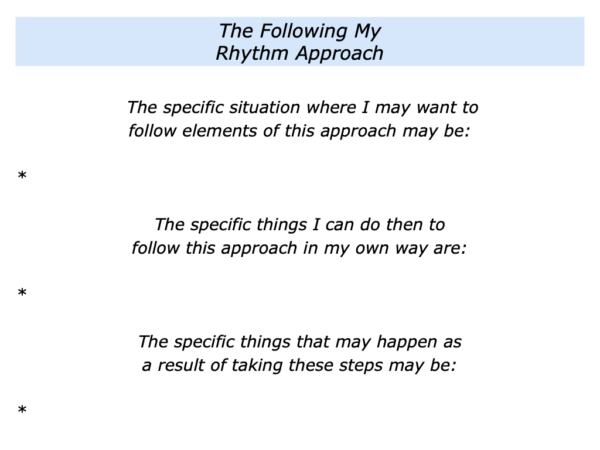






Leave a Reply